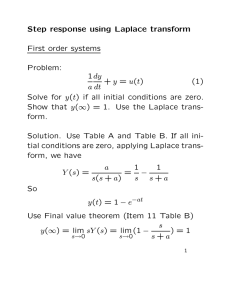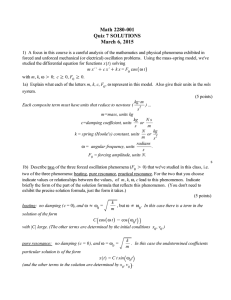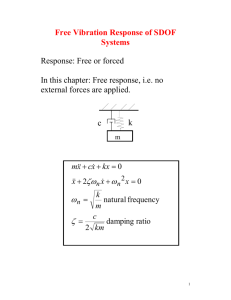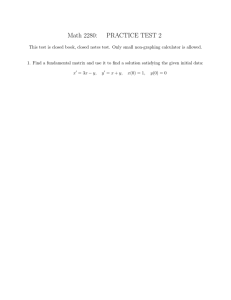Study Sheet
advertisement
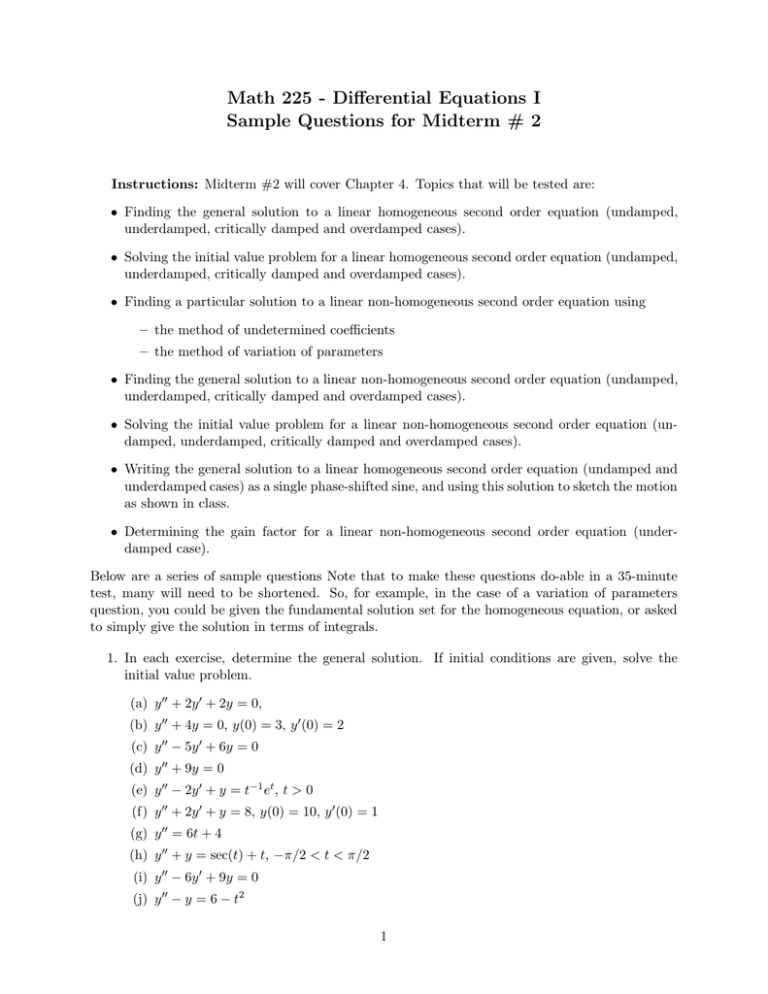
Math 225 - Differential Equations I Sample Questions for Midterm # 2 Instructions: Midterm #2 will cover Chapter 4. Topics that will be tested are: • Finding the general solution to a linear homogeneous second order equation (undamped, underdamped, critically damped and overdamped cases). • Solving the initial value problem for a linear homogeneous second order equation (undamped, underdamped, critically damped and overdamped cases). • Finding a particular solution to a linear non-homogeneous second order equation using – the method of undetermined coefficients – the method of variation of parameters • Finding the general solution to a linear non-homogeneous second order equation (undamped, underdamped, critically damped and overdamped cases). • Solving the initial value problem for a linear non-homogeneous second order equation (undamped, underdamped, critically damped and overdamped cases). • Writing the general solution to a linear homogeneous second order equation (undamped and underdamped cases) as a single phase-shifted sine, and using this solution to sketch the motion as shown in class. • Determining the gain factor for a linear non-homogeneous second order equation (underdamped case). Below are a series of sample questions Note that to make these questions do-able in a 35-minute test, many will need to be shortened. So, for example, in the case of a variation of parameters question, you could be given the fundamental solution set for the homogeneous equation, or asked to simply give the solution in terms of integrals. 1. In each exercise, determine the general solution. If initial conditions are given, solve the initial value problem. (a) y ′′ + 2y ′ + 2y = 0, (b) y ′′ + 4y = 0, y(0) = 3, y ′ (0) = 2 (c) y ′′ − 5y ′ + 6y = 0 (d) y ′′ + 9y = 0 (e) y ′′ − 2y ′ + y = t−1 et , t > 0 (f) y ′′ + 2y ′ + y = 8, y(0) = 10, y ′ (0) = 1 (g) y ′′ = 6t + 4 (h) y ′′ + y = sec(t) + t, −π/2 < t < π/2 (i) y ′′ − 6y ′ + 9y = 0 (j) y ′′ − y = 6 − t2 1 (k) y ′′ − 20y ′ + 100y = 0 (l) y ′′ − 4y ′ = 0 (m) y ′′ + 4y = 2 tan(2t) − et (n) y ′′ + y = 3 sec(t) − t2 + 1, y(0) = 1, y ′ (0) = −2 2. Express a particular solution to the differential equations below using definite integrals. Then evaluate the integrals and obtain a particular solution in closed form. (a) y ′′ − y = cosh(x) (b) y ′′ − 4y = e2x /x (c) y ′′ + 2y ′ + y = e−t ln(t), t > 0 3. Sketch the behaviour of a forced underdamped system when the forcing is tuned to obtain the maximum possible response. On another set of axes, sketch the behaviour of a forced undamped system at resonance. In natural systems, we never observe true resonance (why?), but we do observe behaviour close to resonance. 4. Explain why sound waves made the wine glass shatter (see pre-reading #17). 5. Consider the mass-spring system with mass m = 1, damping b = 2 and spring constant k = 10 forced at frequency γ, and allow γ to vary. What is the maximum possible response from the system? 6. Suppose a forced, underdamped masss-spring system has the steady-state solution yp (t) = p 20 (49 − 160)2 + (9)(16) sin(4t + θ). What are the mass, damping constant and spring constant of the system? Write down the differential equation that describes the motion. 7. What are the two components of the solution of a mass-spring system that is underdamped and sinusoidally forced? 8. What is the amplitude of a forced mass-spring system in true resonance? 2 Answers 1. In each exercise, determine the general solution. If initial conditions are given, solve the initial value problem. (a) y = e−t (c1 cos(t) + c2 sin(t)), (b) y = 3 cos(2t) + sin(2t) (c) y = c1 e3t + c2 e2t (d) y = c1 cos(3t) + c2 sin(3t) (e) y = c1 et + c2 tet + tet ln(t) (f) y = 2e−t + 3te−t + 8 (g) y = c1 + c2 t + t3 + 2t2 (h) y = c1 cos(t) + c2 sin(t) + (ln(cos(t))) cos(t) + t sin(t) + t (i) y = c1 e3t + c2 te3t (j) y = c1 et + c2 e−t + t2 − 4 (k) y = c1 e10t + c2 te10t (l) y = c1 + c2 e4t (m) y = t−4 [c1 cos(ln(t)) + c2 sin(ln(t))] (n) y = −2 cos(t) − 5 sin(t) + 3 cos(t) ln(cos(t)) + 3t sin(t) − t2 + 3 2. Express a particular solution to the differential equations below using definite integrals (i.e. solve the constraints for v1′ and v2′ and set up the integrals, but do not integrate). Then evaluate the integrals and obtain a particular solution in closed form. (a) Integral form: x yp (x) = e 1 + e−2s ; ds + e−x 4 Z Z −1 − e2s ; ds 4 Final solution: yp (x) = c1 ex + c2 e−x + (1/2)x sinh(x) (b) Integral form: 2x yp (x) = e Z 1 ; ds − e−2x 4s Z e2s ; ds 4s Final solution: 2x y = c1 e −2x + c2 e 2x + (1/4) ∗ e −2x ln |x| − e Z x 4t e /tdt x0 (c) Integral form: −t yp (t) = e Z −t (−s ln(s)); ds + te Z ln(s); ds Final solution: y = c1 e−t + c2 te−t + (1/2) ∗ t2 e−t ln(t) − (3/4)t2 e−t 3 3. In Figure 1 I have plotted (left) the solution to a forced underdamped system at “resonance” (at maximum response) and (right) the solution to a forced undamped system at true resonance. The equations governing the two systems are y ′′ + y ′ + ω02 y = F cos(ω t) and y ′′ + ω0 y = F cos(ω0 t) where ω0 = 10π and F = 8πω0 . Notice that when damping is present, the growth of the amplitude slows down and eventually stops. We can never observe true resonance in the real world since damping is always present. But we can still observe large growth in the amplitude of the response, as shown by the left hand plot below. 4. Explain why sound waves made the wine glass shatter (see pre-reading #17). The wine glass is a very stiff oscillator (high k, low b), and so in the presence of sound waves (which are also oscillatory) behaves like a forced, underdamped oscillator. The wine glass in the video was forced with a sound wave that very closely matched the natural frequency of the wine glass, and so the wine glass oscillated in response. Because of the very low damping constant, the amplitude of the oscillations of the glass are predicted to be very large (see, for example, the plot of M (γ) in the text: The magnitude of the gain factor can be several times the amplitude of the forcing. In the case of the wine glass, the amplitude of the oscillations is predicted by linear theory to increase to several orders of magnitude larger than the forcing, but before this amplitude was reached the mechanical properties of the system were exceeded and the glass broke. Essentially, the glass “shivered itself to pieces”. 5. The maximum possible response is F0 times the peak value of the gain factor function. We find r √ b2 k dM (γ) 8 = 0 ⇔ γr = − = dγ m 2m2 and so the maximum possible response is √ F0 F0 F0 F0 M ( 8) = p = =p . 6 (k − mγr2 )2 + γr2 b2 (10 − 8)2 + 8 ∗ 4 6. Comparing the particular solution to the theory, we see that mass m = 10, spring constant k = 49, damping constant b = 3. Thus, the differential equation is 10y ′′ + 3y ′ + 49y = 20 cos(4t). 7. The solution of a forced underdamped mass-spring system is made of a transient component, from the solution to the associated homogeneous system, and a steady-state component, driven by the forcing. As the names imply, the transient component decays quickly, and so becomes dominated by the steady-state solution. 8. A forced mass-spring system in true resonance has an amplitude that increases linearly with time. That is, the solution is of the form y(t) = At sin(ωt) + Bt cos(ωt) where ω = p (k/m) and A and B are integration constants. 4 forced underdamped system at "resonance" forced undamped system at true resonance 25 150 20 100 15 10 50 0 y y 5 0 −5 −50 −10 −15 −100 −20 −25 0 1 2 3 4 t 5 6 7 −150 8 0 1 2 3 4 5 t 6 7 8 9 10 Figure 1: Two systems forced at the frequency producing maximal response. Left plot: Solution to a forced underdamped system at “resonance”. Note that the damping eventually contains the growth of the amplitude. Right plot: Solution to a forced undamped system at true resonance. Note that the amplitude increases linearly without time. That is, the growth in the amplitude is unbounded. 5
